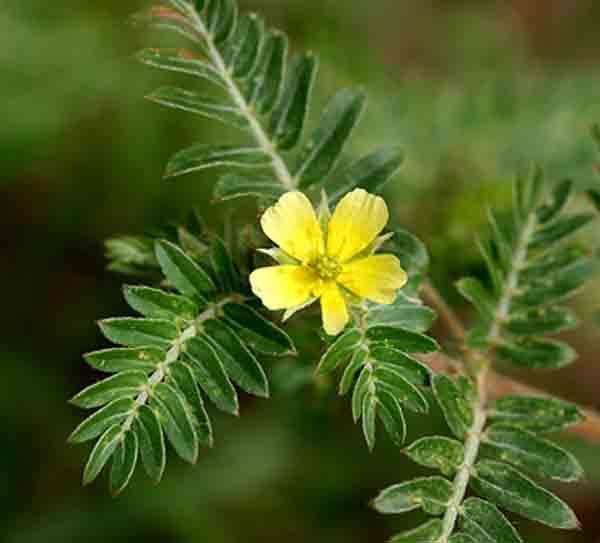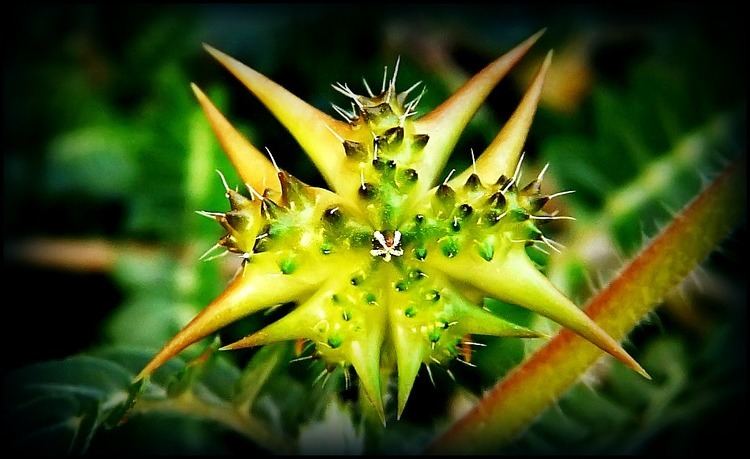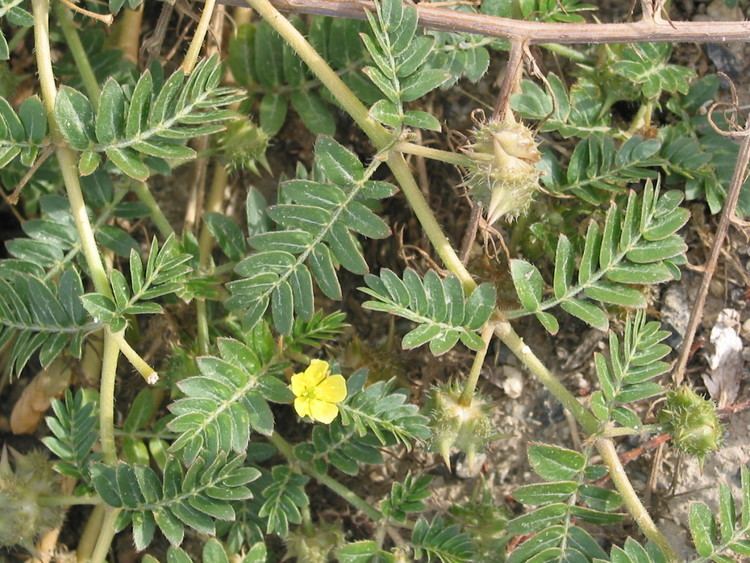Higher classification Puncture vine | Genus Tribulus Rank Species | |
 | ||
Similar Fenugreek, Damiana, Maidenhair tree, Guarana, Asian Ginseng | ||
Puncture vine tribulus terrestris
Tribulus terrestris is an annual plant in the caltrop family (Zygophyllaceae) widely distributed around the world, that is adapted to grow in dry climate locations in which few other plants can survive.
Contents
- Puncture vine tribulus terrestris
- Gokshura or tribulus terrestris medicinal herb
- Description
- Habitat and range
- Growth pattern
- Leaves and stem
- Inflorescence
- Fruit
- Etymology
- Cultivation and uses
- Siddha
- Ayurveda
- Unani
- Kashmiri
- Traditional Chinese Medicine
- Dietary supplement
- In animals
- In humans
- Eradication
- Physical
- Chemical
- Biological
- Toxicity
- Phytochemistry
- References

It is an invasive species in North America. Like many weedy species, this plant has many common names, including goat's-head, bindii, bullhead, burra gokharu, bhakhdi, caltrop, small caltrops, cat's-head, devil's eyelashes, devil's-thorn, devil's-weed, puncture vine, puncturevine, and tackweed.

Gokshura or tribulus terrestris medicinal herb
Description
Tribulus terrestris is a taprooted herbaceous perennial plant that grows as a summer annual in colder climates.
Habitat and range

It is native to warm temperate and tropical regions of the Old World in southern Europe, southern Asia, throughout Africa, and Australia. It can thrive even in desert climates and poor soil.

A network of fine rootlets arise from the taproot to take advantage of soil moisture, by which the plant can survive in very arid conditions.
Growth pattern
The stems radiate from the crown to a diameter of about 10 cm (3.9 in) to over 1 m (3 ft 3 in), often branching. They are usually prostrate, forming flat patches, though they may grow more upwards in shade or among taller plants.
Leaves and stem
Stems branch from the crown and are densely hairy. Leaves are opposite and pinnately compound. Densely hairy leaflets are opposite and up to 3 mm (0.12 in) long.
Inflorescence
The flowers are 4–10 mm (0.16–0.39 in) wide, with five lemon-yellow petals, five sepals, and ten stamens. In Southern California, it blooms from April through October, where it is highly invasive in waste places and disturbed sites.
Fruit
A week after each flower blooms, it is followed by a fruit that easily falls apart into five nutlets or burs.
The nutlets are hard and bear two to four sharp spines, 10 mm (0.39 in) long and 4–6 mm (0.16–0.24 in) broad point-to-point. These nutlets strikingly resemble goats' or bulls' heads; the "horns" are sharp enough to puncture bicycle tires and lawn mower tires. They can also cause painful injury to bare feet; however, they are also large enough to pull out as soon as they pierce into the sole, and the resultant hole is only slightly larger than stepping on a push pin if it goes all the way in.
Within each nutlet, seeds are stacked on top of each other, separated by a hard membrane. As an adaptation to dry climates, the largest seed germinates first, while the others may wait until more moisture is available before germinating.
The spines of the nutlets point upward, where they stick into feet and fur of animals, and are thereby dispersed. This causes damage to domesticated livestock and degrades wool.
Etymology
The Greek word, τρίβολος meaning 'water-chestnut', translated into Latin as tribulos. The Latin name tribulus originally meant the caltrop (a spiky weapon), but in Classical times already the word meant this plant as well.
Cultivation and uses
The plant is widely naturalized in the Americas and also in Australia south of its native range. In some states in the United States, it is considered a noxious weed and an invasive species. It is a declared plant in South Australia.
It has been reported that the seeds or nutlets have been used in homicidal weapons smeared with the juice of Acokanthera venenata in southern Africa.
Siddha
In Siddha medicine, Tribulus terrestris is known in Tamil as Nerunjil, yanai vanangi, thirikandam, siru nerunjil. This whole plant is used in the form of decoction to treat urinary tract infections, urolithiasis, dysmenorrhea, edema.
Ayurveda
In Ayurvedic pharmacology, tribulus terrestris is used as a powder form of the aerial parts, particularly the fruits, and it is known in Sanskrit as gokshura, meaning the "cow's hoof", possibly because the small thorns tend to get stuck on grazing animals. Nevertheless, an unrelated plant, pedalium is also known as gokshura, more specifically as bada gokshura ("big cow's hoof"), whereas the gokshura proper is referred to as chhota gokshura ("small cow's hoof"). The two herbs are often found mixed in powder blends used.
Gokshura is believed to contribute to overall physical, as well as sexual, strength by building all the tissues, especially shukra dhatu (reproductive tissue) but it is not considered as a particular vajikarana (sexual functions) herb. It is believed to be useful in kidney, bladder, urinary tract and uro-genital related conditions, where it is said to act as a diuretic.
Unani
Tribulus terrestris is used in Unani under the Urdu name Khar-e-Khasak Khurd and the pedalium is referred to as Khar-e-Khasak Kalan. Their administration and indications are essentially similar with Ayurveda.
Kashmiri
Tribulus terrestris is called Mitser Kaend (kund singular) in Kashmiri. They are used as a diuretic. A tea made out of them is given to treat fevers of all kinds.
Traditional Chinese Medicine
In traditional Chinese medicine Tribulus terrestris is known under the name bai ji li (白蒺藜). Tribulus terrestris known as ci ji li (刺蒺藜). "Confusion with Astragali complanati Semen (sha yuan zi) originally known as white ji li (白蒺藜 bai ji li), led some writers to attribute tonifying properties to this herb ..."
Dietary supplement
Some body builders use T. terrestris extract as a dietary supplement with the belief that it increases testosterone levels. The belief was popularized by the American bodybuilder Jeffrey Petermann in the early 1970s. However, T. terrestris has failed to increase testosterone levels in controlled studies. It has also failed to demonstrate strength-enhancing properties, a finding indicating that the purported anabolic steroid effects of Tribulus terrestris are untrue.
In animals
A single study has shown that T. terrestris can alter sexual behavior in castrated rats. It appears to do so by stimulating androgen receptors in the brain. A research review conducted in 2000 stated that the lack of data outside of this study prevents generalizing the results to humans, particularly healthy individuals.
Animal studies in rats, rabbits, and primates have demonstrated ambiguous results. One study found that administration of Tribulus terrestris extract can produce statistically significant increases in levels of testosterone, dihydrotestosterone, and dehydroepiandrosterone, and produces effects suggestive of aphrodisiac activity.
In humans
A recent study found that T. terrestris caused no increase in testosterone or LH in young men, and another found that a commercial supplement containing androstenedione and herbal extracts including T. terrestris, was no more effective at raising testosterone levels than androstenedione alone.
The effect of a hydroalcoholic extract of Tribulus terrestris on serum glucose and lipid profile of women with diabetes mellitus was investigated in another human study.
T. terrestris has long been used empirically to propel urinary stones. T.terrestris had also evoked a contractile activity on Guinea pig ileum.The diuretic and contractile effects of T. terrestris indicate that it has the potential of propelling urinary stones.
A small research study of 67 women was published in 2014, finding "Tribulus terrestris may safely and effectively improve desire in women with hypoactive sexual desire disorder."
Eradication
Where this is a non-indigenous species, eradication methods are often sought. There are both biological and herbicidal solutions to the problem, but none of them provide a solution that is both quick and long-lasting, because T. terrestris seeds remain viable for up to seven years on average.
Physical
In smaller areas, T. terrestris is best controlled with manual removal, using a hoe to cut the plant off at its taproot. While this is effective, removing the entire plant by gripping the taproot, stem or trunk and pulling upward to remove the taproot is far more effective. This requires monitoring the area and removing the weed throughout the preseeding time (late spring and early summer in many temperate areas). This will greatly reduce the prevalence of the weed the following year. Mowing is not an effective method of eradication, because the plant grows flat against the ground.
Another avenue of physical eradication is to crowd out the opportunistic weed by providing good competition from favorable plants. Aerating compacted sites and planting competitive desirable plants, including broad-leaved grasses such as St. Augustine, can reduce the effect of T. terrestris by reducing resources available to the weed.
In June 2014, the town of Irrigon, Oregon, announced it would pay a bounty of one dollar for each large trash bag of puncturevine.
Chemical
Chemical control is generally recommended for home control of T. terrestris. There are few pre-emergent herbicides that are effective. Products containing oryzalin, benefin, or trifluralin will provide partial control of germinating seeds. These must be applied prior to germination (late winter to midspring).
After plants have emerged from the soil (postemergent), products containing 2,4-dichlorophenoxyacetic acid (2,4-D), glyphosate, and dicamba are effective on T. terrestris. Like most postemergents, they are more effectively maintained when caught small and young. Dicamba and 2,4-D will cause harm to most broad-leaved plants, so the user should take care to avoid over-application. They can be applied to lawns without injuring the desired grass. Glyphosate will kill or injure most plants, so it should only be used as a spot treatment or on solid stands of the weed. A product from DuPont called Pastora is highly effective but expensive and not for lawn use.
Biological
Two weevils, Microlarinus lareynii and M. lypriformis, native to India, France, and Italy, were introduced into the United States as biocontrol agents in 1961. Both species of weevils are available for purchase from biological suppliers, but purchase and release is not often recommended because weevils collected from other areas may not survive at the purchaser's location.
Microlarinus lareynii is a seed weevil that deposits its eggs in the young burr or flower bud. The larvae feed on and destroy the seeds before they pupate, emerge, disperse, and start the cycle over again. Its life cycle time is 19 to 24 days. Microlarinus lypriformis is a stem weevil that has a similar life cycle, excepting the location of the eggs, which includes the undersides of stems, branches, and the root crown. The larvae tunnel in the pith where they feed and pupate. Adults of both species overwinter in plant debris. Although the stem weevil is slightly more effective than the seed weevil when each is used alone, the weevils are most effective if used together and the T. terrestris plant is moisture-stressed.
Toxicity
Consumption of T. terrestris causes the disease tribulosis in sheep. Toxins in the plant can cause liver damage and accumulation of phylloerythrin in the blood.
Phytochemistry
One chemical compound found in T. terrestris is protodioscin (PTN). Also, T. terrestris was shown to have strong inhibitory activity on COX-2.
Two alkaloids that seem to cause limb paresis (staggers) in sheep that eat Tribulus terrestulis are the beta-carboline alkaloids harman (harmane) and norharman (norharmane). The alkaloid content of dried foliage is about 44 mg/kg.
Another phytosterol that is found in T. terrestris is called hecogenin. Hecogenin has application in the synthesis of 11-oxaethisterone.
